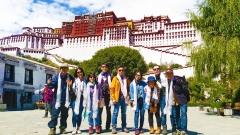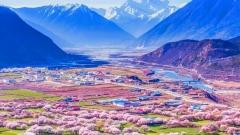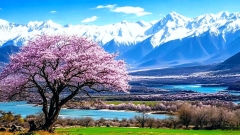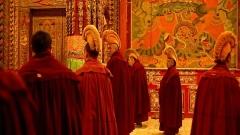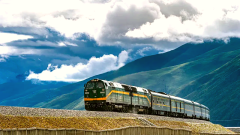The Three Great Monasteries of Tibet—Drepung, Sera, and Ganden—are pillars of Tibetan Buddhism and culture. Founded in the 15th century by Tsongkhapa and his disciples, they shaped Tibet’s spiritual, educational, and political life. Known for grand architecture, sacred relics, and vibrant festivals, these monasteries remain living centers of faith, philosophy, and cultural heritage.
The Gelug School and the Foundation of the Three Great Monasteries
To fully appreciate the significance of Tibet’s three great monasteries, one must understand the context of their creation.
The Gelug School of Tibetan Buddhism, also known as the “Yellow Hat School,” was founded by Je Tsongkhapa (1357–1419), a reformer and scholar. His teachings emphasized strict monastic discipline, deep philosophical inquiry, and the integration of meditation with scholastic study. His disciples went on to establish monasteries that became centers of learning and practice, most prominently:
-
Ganden Monastery (1409): Founded by Tsongkhapa himself, symbolizing the origins of the Gelug order.
-
Drepung Monastery (1416): Established by Jamyang Chöjé, a direct disciple of Tsongkhapa, becoming the largest monastery in Tibet.
-
Sera Monastery (1419): Founded by Jamchen Chöjé, another disciple of Tsongkhapa, noted for its debating tradition.
Together, these three monasteries formed the backbone of Gelugpa influence in Tibet, nurturing generations of monks, scholars, and leaders—including many of the Dalai Lamas, who emerged from these institutions.
Drepung Monastery: The Seat of Learning and Power
Historical Background
Founded in 1416 by Jamyang Chöjé, Drepung Monastery is located about 5 km west of Lhasa. It soon became the largest monastery in Tibet and the world, with an estimated 10,000 monks at its peak. Drepung functioned not only as a spiritual institution but also as a seat of political power. Several Dalai Lamas lived here before the construction of the Potala Palace.
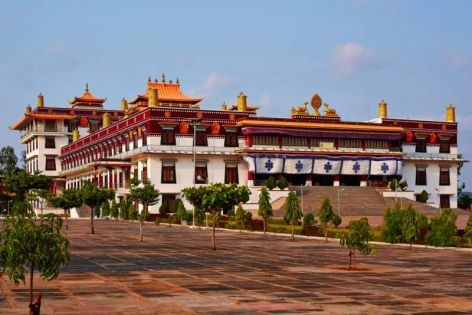
Drepung Monastery
Religious and Cultural Role
-
Education: Drepung was renowned as a “monastic university,” offering advanced studies in philosophy, logic, metaphysics, and Buddhist scriptures. Students spent decades mastering the Five Great Treatises of Buddhist Philosophy.
-
Political Influence: The monastery was closely tied to the Dalai Lama institution. The 2nd, 3rd, 4th, and 5th Dalai Lamas resided at Drepung before moving to the Potala.
-
Spiritual Practices: It emphasized both scholastic rigor and meditative practice, serving as a training ground for some of Tibet’s greatest scholars.
Architecture and Layout
Drepung’s sprawling complex resembles a white sea of buildings cascading down the mountain slopes. The name “Drepung” literally means “rice heap monastery,” a reference to its clustered whitewashed structures. Notable features include:
-
Ganden Podrang Palace: Residence of early Dalai Lamas.
-
Four Colleges (Dratsang): Each with its own chapels, classrooms, and debating courtyards.
-
Assembly Hall: Adorned with massive thangkas and statues, where large gatherings are held.
Festivals
The highlight is the Shoton Festival (Yogurt Festival) in August, when a giant thangka of the Buddha is unveiled on the hillside, attracting thousands of pilgrims and tourists.
Sera Monastery: The Monastic Debating School
Historical Background
Founded in 1419 by Jamchen Chöjé, Sera Monastery lies at the foot of Tatipu Hill, about 5 km north of Lhasa. At its height, it housed 5,000–7,000 monks. Its name “Sera” means “wild rose”, referencing the wild roses that once grew in the area.
Unique Features
-
Debating Tradition: Sera is world-famous for its monastic debates. Monks gather in courtyards to practice dialectical reasoning, debating philosophical questions with emphatic gestures—clapping hands, stamping feet, and questioning sharply. This method sharpens logic and understanding of Buddhist texts.
-
Scholastic Training: Like Drepung, it offers rigorous training in Buddhist philosophy, with debates being central to progression toward advanced degrees (Geshe degree).
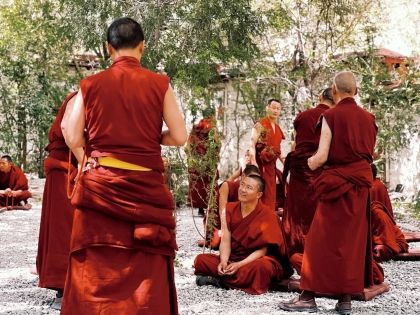
Sera Monks Debate
Architecture
Sera’s architecture is less sprawling than Drepung but equally significant:
-
Great Assembly Hall: Houses murals, statues, and sacred texts.
-
Three Colleges (Dratsang): Each focusing on different philosophical traditions.
-
Debating Courtyards: Large open-air spaces shaded by trees, where debates take place daily.
Festivals
-
Sera Bengqin Festival: A major event held in the first lunar month, when monks bless the faithful with the “Papal Crown” believed to have miraculous power.
-
Debate Demonstrations: Held regularly, these sessions now attract both pilgrims and tourists eager to witness the intellectual vibrancy of Tibetan Buddhism.
Ganden Monastery: The Spiritual Heart of the Gelug School
Historical Background
Ganden Monastery was founded in 1409 by Je Tsongkhapa himself, making it the earliest and most spiritually important Gelug monastery. Located 40 km east of Lhasa, it sits dramatically atop Wangbur Mountain at an altitude of 4,300 meters.
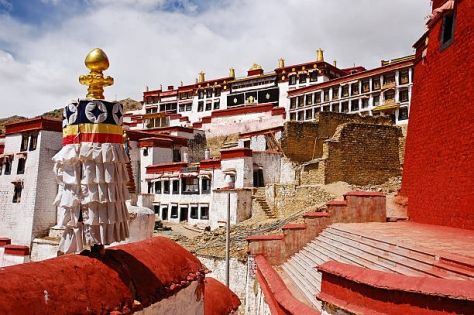
Ganden Monastery
Religious Importance
-
Founder’s Legacy: As the personal monastery of Tsongkhapa, Ganden became the spiritual nucleus of the Gelug order. After his death in 1419, his body was enshrined here, turning it into a sacred pilgrimage site.
-
Ganden Tripa: The head of the Gelug School resides here. Unlike the Dalai Lama, the Ganden Tripa is not a reincarnated lama but appointed based on scholarly merit, underscoring the Gelug emphasis on learning.
Architecture
-
Tsokchen Hall: The main assembly hall, housing numerous sacred relics.
-
Serdung (Golden Tomb): Originally containing Tsongkhapa’s preserved body.
-
Kora Path: A pilgrimage circuit around the monastery offering panoramic views of the Lhasa River Valley.
Festivals and Pilgrimage
-
Ganden Thangka Festival: Held in July/August, when a giant thangka is unveiled.
-
Pilgrimage Significance: Devotees walk the Ganden Kora, a sacred circumambulation path, often prostrating along the way.
Comparative Cultural Significance
Centers of Education
All three monasteries functioned as monastic universities, specializing in logic, philosophy, and scripture. Together, they produced generations of scholars who spread Gelug teachings across Tibet, Mongolia, and beyond.
Political Role
Drepung, as the residence of the Dalai Lama, wielded significant political power. Sera was influential through its intellectual rigor, shaping policies through scholars. Ganden, as the seat of the Gelugpa leader, represented spiritual authority.
Artistic and Architectural Heritage
-
Drepung: monumental scale, symbolic of monastic power.
-
Sera: functional courtyards designed for debates.
-
Ganden: high-altitude setting with sacred relics.
Festivals and Community Engagement
Each monastery remains deeply tied to local communities through festivals, rituals, and pilgrimages, keeping cultural traditions alive.
The Three Great Monasteries in Modern Tibet
Despite historical upheavals, including the Cultural Revolution, the monasteries have undergone restoration and continue to thrive:
-
They serve as spiritual centers for Tibetans and major attractions for travelers.
-
Monks continue to study, debate, and practice rituals, preserving centuries-old traditions.
-
Tourism has made them accessible to global audiences, providing opportunities for cultural exchange but also raising questions about preservation and commercialization.
Conclusion
The Three Great Monasteries of Tibet—Drepung, Sera, and Ganden—are not merely religious sites but living symbols of Tibetan identity. They embody the intellectual rigor, spiritual devotion, and cultural vibrancy of the Tibetan people.
For travelers, a visit to these monasteries offers more than sightseeing; it provides a window into a world where philosophy, ritual, art, and community merge into a profound cultural experience. For Tibetans, these monasteries remain cornerstones of faith and tradition, linking past to present.
In an era of rapid change, the monasteries continue to inspire awe and reverence, reminding us that Tibet’s spiritual heart beats strongly in the chanting halls, debating courtyards, and sacred pilgrimage paths of Drepung, Sera, and Ganden.





